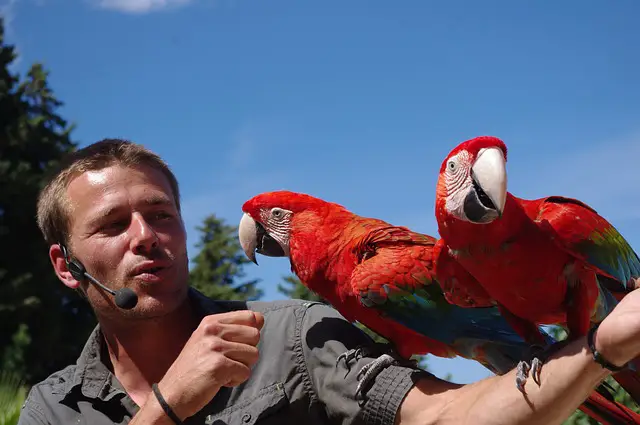Parrots are known for their remarkable ability to mimic human speech, but have you ever wondered about their natural vocalizations? Understanding these sounds is crucial for pet owners who want to provide the best possible care for their birds.
So, what sound does a parrot make? Parrots can produce various vocalizations, from screeches and squawks to purrs and whistles. Each species has its unique vocalization patterns, which serve various purposes, such as communication with other birds, warning signals, and expressing emotions.
This article will explore the factors that affect parrot vocalizations, such as socialization and environment, and how parrots can imitate human speech. You’ll also discover what different parrot sounds mean.
An Overview Of Sounds That Parrots Make
Here’s a table summarizing the sounds that parrots make and their potential meanings:
| Sound | Meaning |
| Talking | Mimicry, social interaction |
| Chattering | Contentment, curiosity |
| Purring | Contentment, relaxation |
| Squawking | Attention-seeking, alarm |
| Hissing | Fear, aggression |
| Singing | Happiness, social interaction |
| Whistling | Attention-seeking, mimicry |
| Shrieking | Alarm, fear, distress |
| Screeching/Screaming | Distress, fear, aggression, frustration |
| Growling | Aggression, warning |
| Chirping | Happiness, social interaction |
| Tongue Grinding | Relaxation, contentment |
| Beak Grinding | Aggression, territorial behavior |
11 Parrot Sounds Explained With Their Meanings
Some of the most common types of parrot vocalizations include:
1. Talking
This is the most famous sound that parrots are known for. Parrots, unlike most other birds, have a specialized vocal organ called the syrinx at the base of their trachea, allowing them to produce a wide range of sounds.
Parrots need exposure to human speech during a critical development period to learn to talk. During this time, usually from a few months to a year, parrots can learn and imitate the sounds and words they hear around them.
In addition to their vocal learning ability, parrots also have a high cognitive and social intelligence level. This is due to their medial spiriform nucleus. They also have developed more pallium cells than other birds. That way, they can understand, use language meaningfully, and even use words to communicate their wants and needs to their owners.
2. Chattering
This is a sound that parrots make by rapidly moving their tongues against the roof of their mouth. It is a softer sound often used by parrots to communicate contentment or excitement. Chattering can also signify playfulness; parrots may chatter while engaging in social activities or exploring their environment.
3. Purring
Purring is a soft, rolling sound that parrots make by vibrating their throat muscles. It is often associated with contentment and relaxation. Not all parrots can purr, but those that do, do it while petting or holding.
Purring can also indicate that the parrots are friendly and approachable. You may also notice signs like the parrot grooming or flapping its tail before you. Note that purring and growling may sound similar. Growling occurs when the parrot is angry. So look at other signs, such as the parrot’s demeanor, to know if it is purring or growling.
4. Squawking
Parrots squawk when they are scared or agitated. This loud and harsh sound might be accompanied by the parrot flying restlessly in the cage and puffing up its feathers. It may also be used as a warning signal, particularly if a parrot perceives a threat to its safety. Threats may include another pet, such as a cat, that the parrot perceives as a predator.
Some parrots may also squawk due to night frights. In such cases, cover the parrot’s cage with a cloth and put it in an area with less traffic.
5. Hissing
Parrots only will hiss when it is stressed or distressed. Hissing is similar to screeching and squawking and only occurs when there is a trigger. Some triggers may include other pets, lack of sleep, or showcasing territorial behavior to other cagemates. It is also often a sign of fear or anxiety, and parrots may hiss in response to unfamiliar stimuli or situations.
If you observe this behavior, it is best to leave the parrot alone and return later when it calms down. If there is anything new or any threat around the parrot, remove it immediately.
6. Singing/ Whistling
Whistles are musical sounds often used by parrots to express pleasure or contentment. They are typically followed by other behaviors, such as bobbing the head or fluffing the feathers. Parrots may also sing/ whistle to attract mates or bond with other flock members. An example of a good whistler is the African Gray Parrot.
Many parrots may also whistle along to tunes they pick up from the household; for example, TV and radio sounds. You can also teach your parrot to whistle your favorite tunes. All you need to do is repeat the tune severally until the parrot starts picking up the tune.
At times, parrots may whistle due to boredom. For example, if you skip playtime with your pet, it will whistle continuously to try and get your attention. Note that whistling is always a positive sound; no parrot whistles when angry or upset.
7. Shrieking/ Screeching / Screaming
Parrots screech or scream for various reasons, but distress, fear, and aggression are the most common. It may be due to the parrot being in a new environment, the parrot not being social, or the presence of a predator. Shrieking can also signify frustration or boredom; parrots may shriek in response to being left alone for long periods.
To minimize screeching, ensure you;
- Provide the parrot with enough toys
- Reduce stressors such as loud noises, other pets, sudden movements, or changes in routine
- Leave the parrot alone if it does not want to be petted
- Ensure the parrot gets enough sleep at night
- Try positive reinforcement, where you reward the parrot every time it is quiet
8. Growling
Like screeching, growling is caused by aggression or distress. It is a low, rumbling sound often accompanied by puffed-up feathers, biting, lashing out, and dilated pupils.
Parrots use it as a warning signal, so if you observe such, keep away till the parrot has calmed down. If you approach it, you may get bitten. You’ll also stress the parrot more, making it more aggressive and irritated.
9. Chirping
Chirping is a soft, melodic sound often used by parrots to communicate with each other. It is a sign of contentment and relaxation, and parrots may chirp while listening to music or with their owners.
This sound can also signify playfulness, and parrots may chirp while swinging on branches or playing with their favorite toy.
At times, parrots may chirp to warn others about impending danger. Each parrot flock has a specific flock chirp which helps them be unified. Also, different species of parrots have different chirps, so chirps may vary.
10. Tongue And Beak Clicking
Tongue clicking means the parrot is happy or excited. This clicking sound occurs when the parrot taps its tongue on their mouth’s roof. It is also often used during the;
- Courtship or mating rituals
- While the parrots are waiting for food
- Playtime
- If a parrot wants attention
- When a parrot is entertaining itself
On the other hand, beak clicking may signify territorial behavior and anger. Beak clicking sounds like a rapid, rhythmic clacking noise made by the bird’s upper and lower beaks coming together repeatedly.
If a parrot feels threatened or defensive, it may click its beak to warn others to back off. You may notice other physical cues such as puffed-up feathers, dilated pupils, and eye pins.
11. Beak Grinding
This is a soft, rhythmic sound that parrots make by grinding their beaks together. It is often associated with relaxation and contentment. Beak grinding can also indicate sleepiness, as parrots may grind their beaks before sleeping.
Why Is My Parrot Not Making Any Noises?
Parrots are generally noisy, so a parrot not making noise is very rare. Here are some possible explanations:
- Environment: Parrots may not feel comfortable or safe in their environment, which can cause them to be quiet and withdrawn. If the bird is new to its surroundings or has recent changes in the household, the parrot may need time to adjust before it feels comfortable enough to vocalize.
- Illness or injury: A sick parrot may be too weak or uncomfortable to vocalize. If you suspect your bird is not feeling well, it’s important to take it to an avian veterinarian for a check-up.
- Fear or anxiety: Fearful or anxious parrots may be too stressed to vocalize. Various factors, such as loud noises, other pets in the household, or a lack of socialization and interaction, can cause this.
- Personality: Some parrots are simply quieter than others. Every bird has its unique personality, and some parrots may be less vocal than others, even if they are otherwise healthy and happy.
Conclusion
Parrots are fascinating creatures that use a variety of vocalizations to communicate with one another and with humans. Each parrot’s sound has a specific meaning that can help owners understand their birds’ behavior and needs. So, parrot owners must be patient and persistent, especially when attempting to modify challenging behaviors.
Positive reinforcement training techniques, combined with lots of love and attention, can assist parrots in learning new behaviors and becoming more at ease in their surroundings. It’s also important for parrot owners to provide a stimulating and enriched environment for their birds, with plenty of toys, perches, and opportunities for exercise and play.

Hello, this is Frank Swanson, the owner, and operator of Pet Info Hut. I created this website as a way to share my love of pets with the world. I have over 7 years of experience working with animals, and I have a passion for helping people care for their pets. I hope that you find my website useful and informative. Thanks for visiting!

